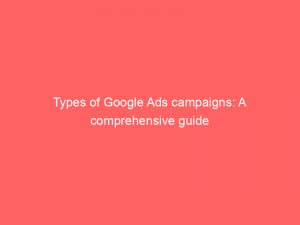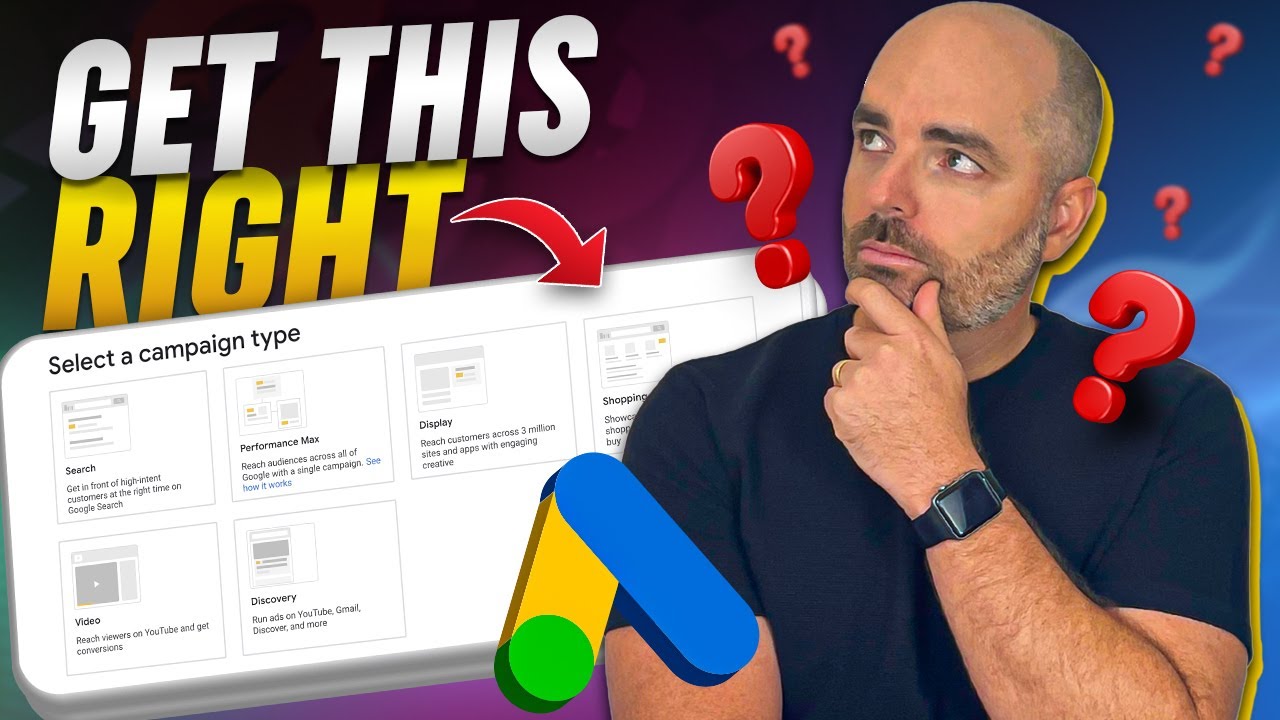When it comes to online advertising, GoogleAds has proven to be a game-changer for businesses around the world. With its vast reach and innovative targeting options, GoogleAds has become a go-to platform for advertisers looking to reach their target audience effectively.
But with so many different types of Google Adscampaigns available, it’s crucial to understand which one is right for your business. From search ads that appear when users search for specific keywords to display ads that appear on relevant websites, each campaign type has its own unique benefits.
In this article, we will explore the various types of Google Ads campaigns and discover how they can help boost your business’s online presence.
Table of Contents
types of google ads campaign
There are several types of Google Ads campaigns that businesses can run to reach their target audience and achieve their marketing goals. These include search network campaigns, display network campaigns, video campaigns, shopping campaigns, app campaigns, and smart campaigns.
Each type of campaign is designed to target a specific platform or medium and offers unique features and targeting options. Overall, these different types of campaigns provide businesses with various options to promote their products and services effectively on Google’s advertising platform.
Key Points:
- Different types of Google Ads campaigns are available to businesses to reach their target audience and meet their marketing goals.
- These campaigns include search network, display network, video, shopping, app, and smart campaigns.
- Each type of campaign is tailored to target specific platforms or mediums and offers distinct features and targeting capabilities.
- These campaigns provide businesses with a range of options to effectively promote their products and services on Google’s advertising platform.
- Search network campaigns focus on reaching customers through text-based ads that appear on Google search results pages.
- Display network campaigns allow businesses to reach customers through image-based ads on websites and apps that are a part of Google’s display network.
Sources
https://support.google.com/google-ads/answer/2567043?hl=en
https://www.demandcurve.com/blog/types-of-google-ads
https://support.google.com/google-ads/answer/1722124?hl=en
https://blog.hubspot.com/marketing/google-adwords-ppc
Check this out:
? Pro Tips:
1. Utilize Display Network Ads: In addition to search ads, Google offers display network ads that appear on websites, blogs, and apps. Take advantage of this type of campaign to increase brand visibility and reach a wider audience.
2. Experiment with Video Ads: Create engaging videos to promote your products or services through Google’s video campaign. Video ads can be displayed on YouTube or partner websites, allowing you to showcase your brand in a visually captivating way.
3. Don’t Neglect App Campaigns: If you have a mobile app, consider running app campaigns on Google Ads. This type of campaign can help you drive app installs and increase user engagement by displaying your ads within other apps or on websites used by your target audience.
4. Use Local Campaigns for Geo-Targeting: If your business targets specific locations, consider running local campaigns to reach potential customers in those areas. Local campaigns allow you to showcase your ads across multiple Google platforms, such as Search, Maps, YouTube, and display networks, to drive foot traffic and increase store visits.
5. Experiment with Smart Campaigns: Google’s Smart campaign feature uses machine learning and automation to optimize your ads for specific goals, such as website visits, phone calls, or store visits. This can be a great option for businesses new to Google Ads or those looking for a more hands-off approach to campaign management.
1. Search Ads Campaigns
Search ads campaigns are the most common type of Google Ads campaign.
These campaigns allow advertisers to display text-based ads on the Google search results page when users enter specific keywords. Search ads appear at the top and bottom of the search results page and are marked as “Ad.” This type of campaign is effective for reaching users who are actively searching for products or services related to the advertiser’s business.
With search ads campaigns, advertisers have control over the keywords they target, ad copy, bidding strategies, and budget.
They can also use ad extensions to provide additional information, such as phone numbers or links to specific pages on their website. It’s important to conduct keyword research to identify the most relevant and popular keywords for the target audience.
2. Display Ads Campaigns
Display ads campaigns allow advertisers to reach a wider audience by displaying visual banner ads on websites within the Google Display Network.
This network includes millions of websites, YouTube videos, and mobile apps. Display ads can include images, videos, or rich media and can be targeted based on audience demographics, interests, or specific websites.
Advertisers have the option to create responsive ads that automatically adjust their size and appearance to fit different ad spaces.
The Google Display Network also offers advanced targeting options, such as remarketing, which allows advertisers to show ads to users who have previously visited their website.
3. Video Ads Campaigns
Video ads campaigns give advertisers the opportunity to display video ads on YouTube and across the Google Display Network.
Video ads can appear before, during, or after YouTube videos or within other video content. They can also be targeted based on audience demographics, interests, or specific YouTube channels.
Advertisers can create different types of video ads, including in-stream ads, which play before or during a YouTube video, and discovery ads, which appear as a thumbnail alongside YouTube search results or related videos.
Video ads can be an excellent way to engage with audiences through storytelling and captivating visuals.
4. App Ads Campaigns
App ads campaigns are designed to promote mobile apps on Google Search, Google Display Network, YouTube, and Google Play.
These campaigns help advertisers generate more app downloads or drive engagement with their app.
With app ads campaigns, advertisers can target specific audiences, such as users who have previously installed their app or those who are likely to be interested in similar apps. They can also benefit from features like deep linking, which takes users directly to specific pages within the app, and app engagement ads, which encourage users to take specific actions within the app itself.
5. Shopping Ads Campaigns
Shopping ads campaigns are particularly suited for retailers who want to showcase their products online.
These campaigns display product listings, including images, prices, and ratings, on the Google search results page or the Google Shopping tab.
Advertisers can upload their product data to Google Merchant Center, where it is used to create shopping ads. Shopping ads are highly visual and can be displayed in a carousel format, increasing the likelihood of attracting user attention.
These campaigns are effective for driving traffic and conversions for e-commerce businesses.
6. Call-Only Ads Campaigns
Call-only ads campaigns are specifically designed for advertisers who want to generate phone calls from potential customers.
These campaigns display ads on mobile devices, focusing on driving phone calls rather than clicks to a website.
Call-only ads include a phone number and a call button, making it easy for users to reach out to the advertiser with a simple tap. Advertisers can track the performance of their call-only ads by monitoring the number of calls received and the duration of the calls.
This type of campaign is ideal for businesses that rely heavily on phone calls, such as service providers or local businesses.
7. Local Ads Campaigns
Local ads campaigns are designed to help businesses drive foot traffic and increase sales at physical store locations.
These campaigns display ads that include a location extension, showing the store’s address, phone number, and a link for directions.
Advertisers can target specific geographic areas and customize their ads based on local store inventory or current promotions. Local ads can appear on all Google platforms, including search results, maps, and the Google Display Network.
This type of campaign is particularly useful for businesses with a brick-and-mortar presence looking to attract local customers.
8. Smart Campaigns
Smart campaigns, formerly known as AdWords Express, are designed for businesses that want to advertise on Google but have limited time and resources to manage their campaigns.
Smart campaigns use Google’s machine learning technology to automatically target relevant audiences and optimize performance.
Advertisers only need to provide basic information, such as business category, ad text, and budget, and Google takes care of the rest. Smart campaigns are simpler to set up and manage compared to other campaign types but still offer powerful targeting options and reporting capabilities.
This type of campaign is suitable for small businesses or beginners in the world of online advertising.
In conclusion, Google Ads offers a wide range of campaign types to suit different advertising goals and target audiences. Whether you want to promote your products through search ads, engage with users through video ads, or drive foot traffic to your local store, Google Ads has a campaign type that can help you achieve your objectives.
Select the right campaign type based on your advertising goals, target audience, and budget, and continuously monitor and optimize your campaigns for optimal results.












